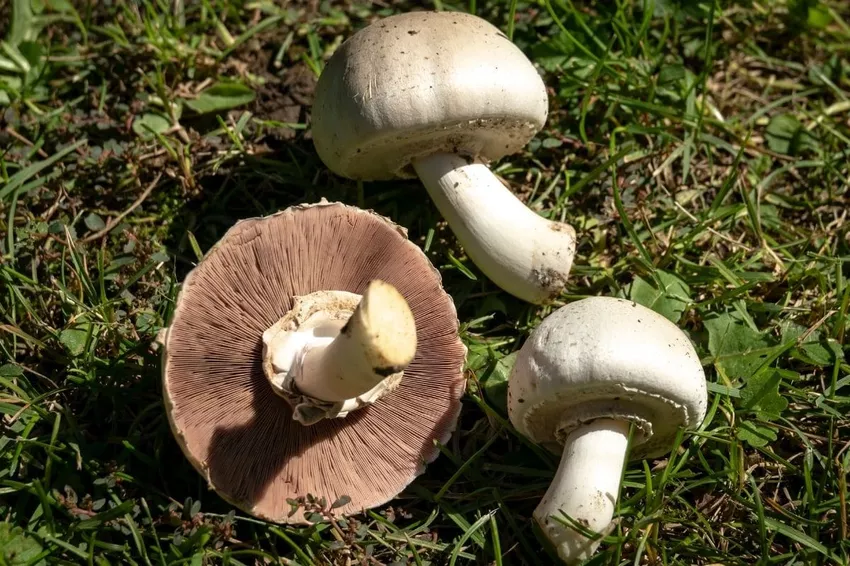- Typical features of meadow mushrooms
- smell and taste
- Happen
- Confused with toxic doubles
- frequently asked Questions

The meadow mushroom (Agaricus campestris), also known as field or meadow gnome, is one of the edible mushrooms. It is very tasty, but unfortunately also easy to confuse with other species, some of which are highly poisonous.
In a nutshell
- Meadow mushrooms are the wild relatives of cultivated mushrooms
- More than 60 types of mushrooms throughout Germany
- found in nature in autumn
- easily confused with poisonous doubles
Typical features of meadow mushrooms
To prevent poisoning, you should only collect mushrooms that you can clearly identify. With some species, this is not always easy, especially for inexperienced collectors, as is the case with meadow mushrooms. But this fungus also has clear characteristics that can be used to distinguish it from poisonous species.

cap
- young caps white, closed and globular
- older hemispherical, cream to light brown
- partly with brownish scales
- very old caps open, almost flat
- up to ten centimeters in diameter
- Cuticle dry and silky
- easy to peel off the pulp
- with increasing age small scales on the top of the hat
- remnants of the covering hanging down at the edge of the hat (velum)
- Completely white when young, rather greyish in age
meat
- white but may discolour
- partly also not discolouring, variable
- faintly reddened at the tip
- slightly yellowish at the base
- Discoloration not as obvious as with the poisonous carbolic mushroom
- one to three centimeters thick
stem and lamellae
- Stalk white, four to seven inches high
- Ring brittle and atrophied, ephemeral
- often only lightly draped with shell remains
- Stem base never thickened, no tuber
- does not turn yellowish
- The tip can be easily separated from the cap meat
- Lamellae initially light pink to flesh pink
- later dark brown, chocolate brown with age
- Lamellae broad, dense, not attached to the stem

Tip: As soon as the lamellae are brown or even black, you should stop collecting this mushroom. It loses consistency and taste, even food poisoning would be possible.
smell and taste
- Smell of meadow mushrooms mildly almond or nutty
- Taste pleasantly mushroomy
- much more intense in young, fresh specimens
- young mushrooms also raw, very tasty
- develop a delicate scent when chewed
Happen
Between June and October it can be found, especially after heavy rainfall, on meadows, pastures or cattle pastures and fields where horse dung is rotting and on fields that have been fertilized with manure. However, it often grows in so-called witch rings. A clear ring of fungi forms. These witch rings can extend over several square meters and provide productive finds in a small space.
Confused with toxic doubles
Death cap (Amanita phalloides)
The cap is white, greenish or lemon-yellow, with the likelihood of confusion with light-colored varieties being particularly high. White fins are a key differentiator. However, even in young field mushrooms, the lamellae are white and only later turn pink to chocolate brown. The death cap mushroom has a clearly separated tuber at the base, which is missing in the meadow mushroom. There are also differences in the location or locality. While the meadow mushroom mainly grows in meadows and fields, the death cap mushroom is mainly found in forest areas.

Carbolic Mushroom (Agaricus xanthodermus)
- from May to October in forests, parks and cemeteries
- Cap white, grey-brown to tawny, flattening with age
- brownish scaly zone in the middle
- Flesh white, turning yellow at base of stem and when cut
- Stalk white, smooth, hanging, partly perishable ring
- Lamellae freely crowded, pink to brown
- The tip can be easily separated from the cap flesh
- Odor unpleasant, strongly carbolic
- not so clearly perceptible in young specimens
- sometimes only occurs when cooking

Tip: The edible aniseed mushroom also turns yellow, but unlike carbolic mushrooms, it smells pleasantly of aniseed, bitter almonds and Christmas cookies.
frequently asked Questions
How can you tell if the meadow mushroom is fresh?Freshness can be recognized by the smell, the look and the way it feels. The head should still be closed or half-closed, the lamellae light to medium brown and the interfaces light. Cap and stalk should feel firm and dry and smell pleasantly fungus-earthy.
What is the best way to distinguish edible mushroom species from poisonous ones?If mushrooms have an unpleasant odor or turn yellow with no perceptible aniseed odor, they are poisonous or inedible. They are edible if they smell of aniseed, bitter almonds or have a pleasant mushroom flavor and if the base of the stem is not yellow. When in doubt, you should of course always keep your hands off it.
What to do if poisoning is suspected?In the event of poisoning, you should call the poison control center or go to a hospital as soon as possible. It is best to take leftovers from the groupage or the meal with you. Under no circumstances should you experiment with any home remedies, it only costs valuable time.